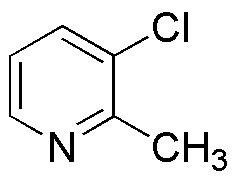3-Chloro-2-methylpyridine is widely utilized in research focused on:
- Pharmaceutical Development: This compound serves as an important intermediate in the synthesis of various pharmaceuticals, particularly in the development of anti-inflammatory and analgesic drugs.
- Agricultural Chemicals: It is used in the formulation of agrochemicals, including pesticides and herbicides, enhancing crop protection and yield.
- Organic Synthesis: Researchers leverage its reactivity in organic synthesis to create complex molecules, making it valuable in academic and industrial laboratories.
- Material Science: The compound is explored for its potential applications in the development of novel materials, such as polymers and coatings, due to its unique chemical properties.
- Analytical Chemistry: It is utilized as a standard in analytical methods, aiding in the detection and quantification of other compounds in various samples.
Información general
Propiedades
Seguridad y normativas
Aplicaciones
3-Chloro-2-methylpyridine is widely utilized in research focused on:
- Pharmaceutical Development: This compound serves as an important intermediate in the synthesis of various pharmaceuticals, particularly in the development of anti-inflammatory and analgesic drugs.
- Agricultural Chemicals: It is used in the formulation of agrochemicals, including pesticides and herbicides, enhancing crop protection and yield.
- Organic Synthesis: Researchers leverage its reactivity in organic synthesis to create complex molecules, making it valuable in academic and industrial laboratories.
- Material Science: The compound is explored for its potential applications in the development of novel materials, such as polymers and coatings, due to its unique chemical properties.
- Analytical Chemistry: It is utilized as a standard in analytical methods, aiding in the detection and quantification of other compounds in various samples.
Documentos
Hojas de datos de seguridad (HDS)
La SDS proporciona información de seguridad completa sobre la manipulación, el almacenamiento y la eliminación del producto.
Especificación del producto (PS)
La PS proporciona un desglose completo de las propiedades del producto, incluida la composición química, el estado físico, la pureza y los requisitos de almacenamiento. También detalla los rangos de calidad aceptables y las aplicaciones previstas del producto.
Certificados de análisis (COA)
Busque certificados de análisis (COA) ingresando el número de lote del producto. Los números de lote y de partida se pueden encontrar en la etiqueta de un producto después de las palabras "Lote" o "Lote".
Número de catálogo
Número de lote/lote
Certificados de origen (COO)
Este certificado de origen confirma el país en el que se fabricó el producto y también detalla los materiales y componentes utilizados en él y si se deriva de fuentes naturales, sintéticas u otras fuentes específicas. Este certificado puede ser necesario para cumplir con las normativas aduaneras, comerciales y regulatorias.
Número de catálogo
Número de lote/lote
Hojas de datos de seguridad (HDS)
La SDS proporciona información de seguridad completa sobre la manipulación, el almacenamiento y la eliminación del producto.
DownloadEspecificación del producto (PS)
La PS proporciona un desglose completo de las propiedades del producto, incluida la composición química, el estado físico, la pureza y los requisitos de almacenamiento. También detalla los rangos de calidad aceptables y las aplicaciones previstas del producto.
DownloadCertificados de análisis (COA)
Busque certificados de análisis (COA) ingresando el número de lote del producto. Los números de lote y de partida se pueden encontrar en la etiqueta de un producto después de las palabras "Lote" o "Lote".
Número de catálogo
Número de lote/lote
Certificados de origen (COO)
Este certificado de origen confirma el país en el que se fabricó el producto y también detalla los materiales y componentes utilizados en él y si se deriva de fuentes naturales, sintéticas u otras fuentes específicas. Este certificado puede ser necesario para cumplir con las normativas aduaneras, comerciales y regulatorias.


